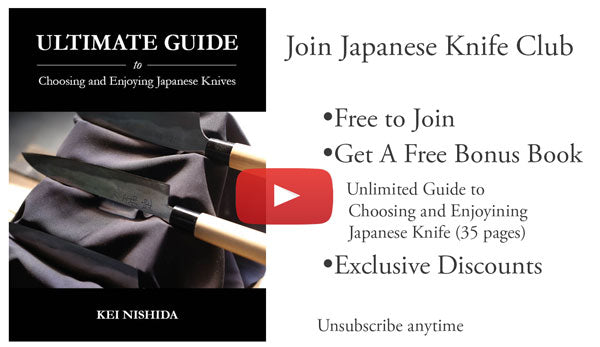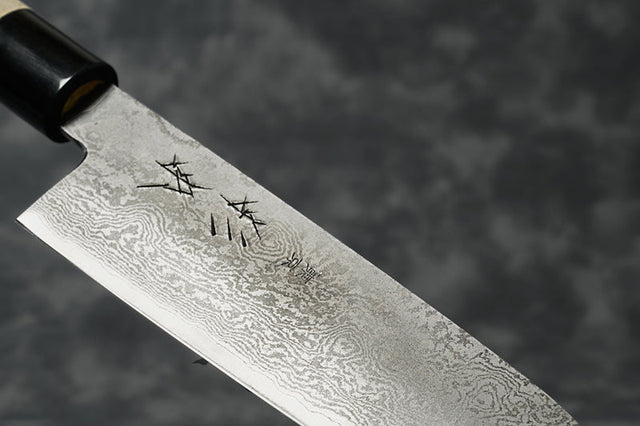Do you ever feel like everything in the world was designed without you in mind? It's a tough life being a lefty. Nothing is ever simple, from scissors to can openers to filling out crosswords. Fortunately, when it comes to knives, there are solutions to your problem (or maybe it's everyone else that has the problem!). So, if you're searching for what options you have when it comes to knives, read on.
Left-Handed Japanese Knives: The Structure of This Article
In the past, it could be a nightmare for left-handed people to find anything designed for them. And even if they did find what they wanted, it would often be charged at a premium. Luckily, this is less of an issue these days. In this article, I'll discuss a few simple options for left-handed knife users and take you through ways you can convert a right-handed knife into a left-handed one.
Single-Handed Knives
In the first place, some may be surprised that there's even such a thing as a right or left-handed knife. It's true; most knives are ambidextrous. But, you must be careful, particularly with Japanese knives, as many are designed only to be used in one hand or the other. That's because the Japanese have traditionally preferred single-bevel knives. Below, I’ll teach you all about bevels, so you know what to look out for.
What’s a Knife Bevel?
A bevel is the sharpened surface that leads to the knife's cutting edge. The most common types are the 50/50 double bevel, 70/30 double bevel, and single bevel. Only the last two are asymmetrical and need to be specifically made as either left or right-handed.

50/50 Double Bevel
Usually, Western knives are sharpened with a 50/50 bevel, and today many Japanese knives designed for the Western market are sharpened this way too. Except for the few knives that may come with an asymmetrical handle, generally, anyone can use a 50/50 bevel.
70/30 Double Bevel
Still considered a double bevel, a 70/30 bevel is asymmetrical. Many Japanese knives are sharpened this way to be left- or right-handed. The idea is that the uneven bevel compensates
for the unevenness in the way the user stands and cuts. Hence, the oddly angled bevel is supposed to make slicing and cutting straighter.

Single Bevel
A single bevel is uniquely Japanese and can be jarring if you've never seen or used one. That's because only one side of the blade is fully sharpened, leaving the other side almost flat with a slightly concave surface leading to the point. This concave surface is called a hollow grind. The idea is that this makes the blade sharper (having a much more acutely angled edge) and significantly more accurate. For this reason, sushi chefs especially love single-bevel knives for their precision. Knives with a single bevel are asymmetrical and either left or right-handed.

Left-Handed Japanese Knives and Knife Conversions
The most obvious solution to being left-handed is to buy a 50/50 double bevel knife, and there's certainly nothing wrong with that - but if you're reading this, the chances are you want the whole Japanese kitchen experience. So, as promised, here are some options available to the left-handed cook looking for something more unique, from simplest to most complex.
You Can Buy Them Left-Handed
That's right; many single-bevel Japanese knives come left-handed. However, many retailers will charge you extra for the privilege, but we offer left-handed knives at no additional cost. You no longer need to compromise with an ambidextrous design; you can get all the benefits of an ultra-sharp and accurate single-bevel knife. Just be aware some retailers may charge you as much as 50% more than a right-handed knife.
Can I Convert the Single-Bevel Right-Handed Knife to a Left-Handed Knife?
The answer is sort of. However, it depends on a few factors that I'll discuss below.
Single-Bevel Conversion
Some single-bevel knives are completely flat on one side. In that case, it is more than possible to sharpen the flat side until it becomes a double-bevel. However, if the knife has a hollow grind on the flat side, the conversion will be significantly riskier as you could potentially ruin the edge. Also, unless you're experienced with knife sharpening, it's best to get a professional to do this for you.
Disclaimer About Single-Bevel Conversion
I have to add a big disclaimer here - even if you do manage to add another bevel to your single-bevel knife; you may make the cutting edge more brittle. The reason is that some Japanese knives are made with a layered steel design, meaning there's a harder, more brittle steel encased in an exterior softer one that supports it. By sharpening the flat side, you can expose more of the brittle core steel and potentially cause chipping. To avoid this, ensure you know everything about the knife you intend to convert and do this at your own risk.

70/30 Bevel Conversion
The disclaimer above still applies, but these types of bevels are much easier to change. All you need to do is sharpen one side more than the other, and eventually, you'll either have a 50/50 double-bevel or a reversed 70/30 double-bevel. At this point, you'll have a left-handed friendly knife.
Left-Handed Handles
95% of the time, you don't need to worry about a knife's handle. But it's always a good idea to be prudent. Most traditional Japanese wa handles are ambidextrous, except for one: D-Shape handles. These come as left or right-handed but make sure you double-check before you buy a knife with a handle like this. You can read my article here to learn more about the D-Shape and other Japanese handles.
Conclusion
Hopefully, you're feeling relieved knowing that you don't have to miss out on a world of excellent Japanese knives. As long as you double-check a few things before purchasing a knife, you can have the same great experience right-handers have - and for once, you might get to watch them get frustrated when they try to use your knife. To help you out, here's a short checklist of things to look out for:
- 50/50 bevel or a left-handed single-bevel
- A single steel, non-concave design is best if you intend on converting the knife
- Double-check the knife’s handle for an asymmetrical design before purchasing
Get Free Bonus Books

Sign up for free to the Japanese Knife Club to get advice and exclusive articles about how to choose Japanese Knives, and tips and tricks for using Japanese knives.
About the author
Kei Nishida
Author, CEO Dream of Japan
Certification: PMP, BS in Computer Science
Education: Western Washington University
Kei Nishida is a passionate advocate of Japanese craftsmanship, a writer, and the founder and CEO of Japanese Knife Co., Japanese Green Tea Co., and Japanese Coffee Co., all part of Dream of Japan.
His journey began with a mission to introduce the world to the exquisite flavors of Japanese green tea. Through Japanese Green Tea Co., he pioneered the import of premium tea grown in nutrient-rich sugarcane soil, earning multiple Global Tea Champion awards. He then expanded into the world of coffee, launching Japanese Coffee Co., the first company to bring Sumiyaki charcoal-roasted coffee to a global audience.
With a deep appreciation for Japanese artistry and tradition, Kei turned his attention to one of Japan’s most revered crafts: bladesmithing. Through Japanese Knife Co., he made handcrafted katana-style knives, created by a renowned katana maker, available outside Japan for the first time. These exceptional knives embody centuries of samurai sword-making expertise, blending tradition with modern functionality for chefs and collectors alike.
Kei’s journey continues as he uncovers and shares Japan’s hidden treasures—one sip, one blade, and one legacy at a time.



















